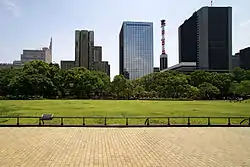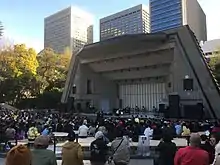Hibiya Park
Hibiya Park (日比谷公園 Hibiya Kōen) is a park in Chiyoda City, Tokyo, Japan. It covers an area of 161,636.66 m2 (40 acres) between the east gardens of the Imperial Palace to the north, the Shinbashi district to the southeast and the Kasumigaseki government district to the west.
| Hibiya Park | |
|---|---|
 | |
| Location | Chiyoda, Tokyo, Japan |
| Coordinates | 35°40′25.3″N 139°45′21.8″E |
| Area | 161,636.66 square metres (39.94129 acres) |
| Created | 1903 |
History
The land was occupied by the estates of the Mōri clan and Nabeshima clan during the Edo period, and it was used for army maneuvers during the Meiji period. It was converted to a park and opened to the public on June 1, 1903.[1]
On September 5, 1905, the park was the origin of the Hibiya riots, a major citywide riot that erupted in protest of the Treaty of Portsmouth which ended the Russo-Japanese War (1904−1905). The riots lasted two days resulting in seventeen people being killed and 331 arrested, as well a large amount of property damage. The riots were against the terms of the treaty, which were lenient to Russia, but also against bureaucrats who refused to accept the will of the people on foreign policy.[2]
The park is famous for the Shisei Kaikan (市政会館), a brick building built in Gothic style in 1929, which once housed the Domei Tsushin state wire service and its postwar successors Kyodo News and Jiji Press. The park is also home to the "Risky Ginkgo," a ginkgo tree that is about 500 years old and almost cost the park's designer his job when he fought to save the tree in 1901.[3]
The park is also known for its open-air concert venue, Hibiya Open-Air Concert Hall (日比谷野外音楽堂), commonly known as Yaon (野音), as well as for its tennis courts (for which reservations are hotly contested because of their proximity to the financial and government districts). World War II took a toll on the park when almost all the trees and fencing was used for the war effort.[4]
Surrounding buildings
- Attorneys' Hall (Japan Federation of Bar Associations headquarters)
- Fukoku Seimei Building
- Imperial Hotel, Tokyo
- Ministry of the Environment
- Ministry of Health, Labour and Welfare
- Ministry of Justice
- Mizuho Bank Building
- Nissay Theatre
- NTT Hibiya Building
- Shinsei Bank Building
- Sumitomo Mitsui Banking Corporation Building
Education
Chiyoda Board of Education operates public elementary and junior high schools. Chiyoda Elementary School (千代田小学校) is the zoned elementary of Hibiya Park.[5] There is a freedom of choice system for junior high schools in Chiyoda Ward, and so there are no specific junior high school zones.[6]
Gallery
 Hibiya Park Lake and Wisteria Grove
Hibiya Park Lake and Wisteria Grove_02.jpg.webp) Shisei Kaikan, former home of Japan's newswires
Shisei Kaikan, former home of Japan's newswires Rai stone in Hibiya Park
Rai stone in Hibiya Park Ongaku-do, Hibiya Park, Tokyo, 1909
Ongaku-do, Hibiya Park, Tokyo, 1909- A few scenes inside the park on a rainy day, 2023

 The Pelican Fountain
The Pelican Fountain
References
- Kameda, Masaaki (2013-06-01). "Hibiya Park celebrates first 110 years this weekend". The Japan Times Online. ISSN 0447-5763. Retrieved 2018-03-20.
- Gordon, Andrew (2014). A modern history of Japan : from Tokugawa times to the present (Third ed.). New York. ISBN 9780199930159. OCLC 826458560.
{{cite book}}: CS1 maint: location missing publisher (link) - "23 Things to do in Hibiya Park".
- "Hibiya Park | Japan Experience".
- "区立小学校の通学区域". Chiyoda Board of Education. Retrieved 2022-10-08.
- "区立中学校の通学区域と学校選択". Chiyoda Board of Education. Retrieved 2022-10-08.
千代田区では、[...]
External links
| Preceded by
none |
Emperor's Cup Final Venue
1921 |
Succeeded by
Toshima-shihan Ground Tokyo |
